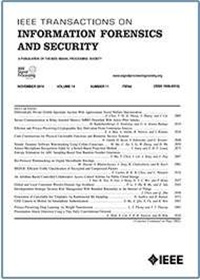基于多智能体离散软角色评价算法的多用户协同抗干扰策略
IF 8
1区 计算机科学
Q1 COMPUTER SCIENCE, THEORY & METHODS
IEEE Transactions on Information Forensics and Security
Pub Date : 2025-03-14
DOI:10.1109/TIFS.2025.3570160
引用次数: 0
摘要
在涉及外部恶意干扰和内部同信道干扰的多用户对抗场景中,环境不稳定性和决策维度的增加导致基于深度强化学习(DRL)的传统抗干扰方案探索不足。agent必须从一个大的动作集中选择策略,导致抗干扰性能明显下降。为了解决这些问题,本文提出了一种基于多智能体离散软行为者批评(MA-DSAC)算法的协同抗干扰策略,集成了频率、功率和调制编码域。该策略首先引入马尔可夫对策来建模和分析多用户抗干扰问题。其次,对软行为者评价(SAC)算法进行离散化,处理多维离散动作空间。最后,通过通信收发器之间的信息交换,基于集中训练分散执行(CTDE)框架,将其扩展为多智能体DRL算法,实现高效的多用户协同抗干扰。仿真结果表明,在固定模式和智能干扰器的各种抗干扰场景中,与传统的基于值的DRL策略(包括独立深度q网络(I-DQN)和深度q学习中的多智能体虚拟探索(MA-VEDQL))相比,所提出的抗干扰策略的性能提高了25%以上。此外,通过通信收发器之间的信息交换,有效缓解了多智能体DRL的不稳定性问题,使通信收发器能够平衡竞争与合作。因此,与独立DSAC (I-DSAC)策略相比,其抗干扰性能提高了6%以上。本文章由计算机程序翻译,如有差异,请以英文原文为准。
Multi-Agent Discrete Soft Actor-Critic Algorithm-Based Multi-User Collaborative Anti-Jamming Strategy
In multi-user adversarial scenarios involving external malicious jamming and internal co-channel interference, environmental instability and increased decision-making dimensions cause traditional deep reinforcement learning (DRL)-based anti-jamming schemes to suffer from insufficient exploration. Agents must choose policies from a large action set, leading to a significant decline in anti-jamming performance. To address these issues, this paper proposes a multi-agent discrete soft actor-critic (MA-DSAC) algorithm-based collaborative anti-jamming strategy, integrating frequency, power, and modulation-coding domains. This strategy first introduces a Markov game to model and analyze the multi-user anti-jamming problem. Next, the soft actor-critic (SAC) algorithm is discretized to handle the multi-dimensional discrete action space. Finally, through information exchange between communication transceivers and based on a centralized training with decentralized execution (CTDE) framework, it is extended to a multi-agent DRL algorithm to achieve efficient multi-user cooperative anti-jamming. Simulation results show that in various anti-jamming scenarios with both fixed-mode and intelligent jammers, the proposed anti-jamming strategy’s performance improves by more than 25% compared to traditional value-based DRL strategies, including independent deep Q-network (I-DQN) and multi-agent virtual exploration in deep Q-learning (MA-VEDQL). Furthermore, through information exchange between communication transceivers, the instability problem of multi-agent DRL is effectively alleviated, enabling the communication transceivers to balance competition and cooperation. Consequently, its anti-jamming performance improves by more than 6% compared to the independent DSAC (I-DSAC) strategy.
求助全文
通过发布文献求助,成功后即可免费获取论文全文。
去求助
来源期刊

IEEE Transactions on Information Forensics and Security
工程技术-工程:电子与电气
CiteScore
14.40
自引率
7.40%
发文量
234
审稿时长
6.5 months
期刊介绍:
The IEEE Transactions on Information Forensics and Security covers the sciences, technologies, and applications relating to information forensics, information security, biometrics, surveillance and systems applications that incorporate these features
 求助内容:
求助内容: 应助结果提醒方式:
应助结果提醒方式:


